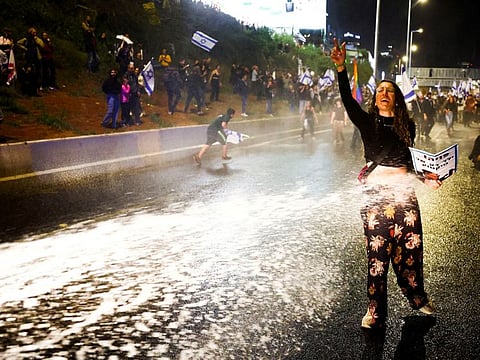Israel’s 7 months of turmoil over judicial reform plan
Overhaul will give parliament power to overrule some of the highest court’s decisions

PARIS: Israel’s controversial judicial reform package, a key clause of which was passed Monday, has sparked some of the biggest protests in the nation’s history.
AFP looks back at the seven-months-old battle between Prime Minister Benjamin Netanyahu’s hard-right government and the demonstrators warning of a grave threat to Israel’s democracy.
Govt unveils reforms
Israel’s Justice Minister Yariv Levin in early January unveils the reforms designed to rein in what the government portrays as a politically-biased and leftist Supreme Court.
The overhaul would give parliament the power to overrule some of the highest court’s decisions, and grant the executive a greater say in the appointment of judges.
Centrist opposition leader Yair Lapid, a former premier, warns that the sweeping package “endangers the entire legal system of the State of Israel”.
Mass protests begin
Opponents of the proposed package take to the streets for a mass protests in Tel Aviv on January 7, the first of what will become weekly demonstrations.
On January 22, some 100,000 people take part, according to media estimates.
The protest movement spreads to Jerusalem and Haifa.
Tech sector workers warn the legislation will drive away investors by undermining the rule of law.
President Isaac Herzog, who as head of state has a largely ceremonial role, first attempts to mediate in the standoff.
Police crackdown
Police in Tel Aviv on March 1 use stun grenades, water cannon and officers on horseback to disperse protesters who attempt to block roads and railways.
Netanyahu accuses the demonstrators of crossing “a red line”.
US President Joe Biden urges Netanyahu to strike a compromise.
On March 14, the Knesset approves in a first reading a clause in the reform package to limit the Supreme Court’s ability to overturn laws it deems unconstitutional.
Reforms ‘paused’
In March, Defence Minister Yoav Gallant breaks rank with Netanyahu, calling the legislation “a clear, immediate and tangible threat to Israel’s security” as the unrest spreads to security agencies.
Netanyahu fires him but, with a general strike looming on March 27, decides to pause the legislation to allow for cross-party talks.
The protests continue regardless, with opponents demanding the reforms be ditched altogether.
Override clause scrapped
On June 14, Israel’s two main opposition leaders, Lapid and Benny Gantz, pull out of talks with the government.
Two weeks later Netanyahu announces that he has scrapped a divisive clause which would allow parliament to override Supreme Court rulings with a simple majority - the most contested element of the bill.
Govt passes key bill
On July 10, parliament adopts in a first reading a key clause that would curb judges’ right to rule on whether a government decision is “reasonable”.
More than 1,100 air force reservists, including many pilots, threaten to suspend volunteer service if parliament adopts the clause.
On July 23, Biden again urges Israel not to rush the increasingly “divisive” reforms.
Herzog, just back from Washington, attempts to broker a compromise in talks with Netanyahu, who is in hospital after having a pacemaker installed.
On July 24, as protests flare again, Netanyahu returns to the Knesset and the government pushes through the key reform clause in a vote boycotted by the opposition.
Sign up for the Daily Briefing
Get the latest news and updates straight to your inbox



